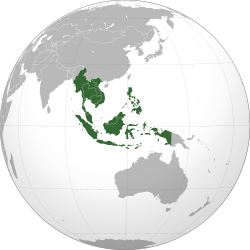The 19th ASEAN Summit: Tackling Floods, Food And Stability – Analysis
By RSIS
This week’s ASEAN Summit will take place against an increasingly unpredictable environment, as seen in the widespread floods in the region. The series of ASEAN-related meetings will have to address the implications for food security and regional stability.
By Yang Razali Kassim
THE UNUSUALLY heavy floods in Thailand and other Southeast Asian countries are having one major impact — a growing sense of urgency in ASEAN over natural calamities and possible food scarcity. Indeed, the 19th ASEAN Summit and related meetings in Bali this week beginning 17 November 2011 may well have to morph into a de facto crisis meeting of regional leaders. Apart from the regular agenda of responding to the region’s strategic, political and economic priorities, nothing can be more pressing for the leaders than floods and food.

Erratic weather caused probably by climate change brought about the current dire situation in Cambodia, Laos, the Philippines, Thailand and Vietnam. In Thailand the floods have severely affected the country’s rice production. Given its position as the world’s largest exporter of rice, Thailand’s woes are also affecting its capacity to feed the ASEAN region. If the situation gets out of hand, there could be repercussions on economic and political stability.
Creeping Urgency
The growing sense of urgency in ASEAN can be detected in the group’s recent official pronouncements. On 12 October 2011, Indonesia, as the current ASEAN Chair, issued a special statement “on the Floods in Southeast Asia”. Jakarta expressed concern over the rising waters deluging some member states. But it also “emphasised the importance of strong cooperation and coordination” among states and the “need for full implementation” of two key mechanisms to deal with food emergencies.
The first mechanism is the ASEAN Agreement on Disaster and Emergency Response or AADMER. The second is the ASEAN Coordinating Centre for Humanitarian Assistance on disaster management, or AHA Centre. However, the message is laced with concern whether AADMER and AHA are fully ready to play their roles to tackle the looming challenges in human security, especially a possible food crisis in the region where rice is a major staple.
Significantly, five days earlier, on 7 October, the ASEAN 10 signed an emergency rice reserve with its three Northeast Asian dialogue partners – China, Japan and South Korea – also known as the ASEAN+3 (APT). Called the ASEAN Plus Three Emergency Rice Reserve (APTERR), the speedy signing of the rice pact underscored the growing collaboration between ASEAN and its Northeast Asian dialogue partners. It also reflects the increasing influence of the three countries on ASEAN. This does suggest that over time, the ASEAN+3 could be a core to catalyse an East Asian identity.
ASEAN officials say that under the APTERR scheme, the 13 countries in the ASEAN+3 will stock up 787,000 tonnes of rice to be used in the event of sudden instabilities in rice supplies caused by natural calamities. The phrase “sudden instabilities” again reflects the growing nervousness within the region over the environmental uncertainties. Indeed, Indonesia’s President Yudhoyono called on ASEAN at the last summit in May in Jakarta to consider using the group’s rice reserve not only in the event of natural disasters but also economic upheaval.
Floods, food, APT and EAS
A senior ASEAN official has suggested that in the long term, APTERR could expand to other staple foods to help the region deal with volatility in food prices. Indonesia’s Vice-President Budiono said cooperation in food is to become more urgent in the coming years.
The United Nations’ Food and Agricultural Organisation has also noted that the rising waters have caused devastation across Southeast Asia, including severe damage to padi fields.
But will floods and food shortage paradoxically bind ASEAN and Northeast Asia closer together?
The growing regional collaboration and cohesion between the two regions within the framework of the ASEAN+3 comes at a time of an evolving strategic landscape. Emerging is a parallel forum called the East Asia Summit (EAS). This involves not only the ASEAN+3 but also Australia, New Zealand and India, as well as two major powers — the United States and Russia. The EAS will be the culmination of the series of ASEAN-related summits this week. It would not be a surprise if the EAS also addresses food security as an urgent item within its remit.
Over time, there is a possibility that both diplomatic tracks – the ASEAN+3 and EAS — will emerge to help ASEAN deal with its growing challenges on the human security front, such as floods and food shortages. In other words, there could be a healthy rivalry for influence between ASEAN-led processes to address the region’s future crises in food and other disasters.
Averting a Southeast Asian Spring?
The larger question is one of regional stability. There are very good reasons why ASEAN is concerned about food security. Rice can be politically sensitive. Writing online in The Diplomat, a young Filipino political leader, Mong Palatino, observed that rice has the potential to spark an uprising. The precedent cited was Vietnam when hungry peasants demanding food, rice and independence led the 1945 revolution. Palatino also quoted a leaked security report in the Philippines – denied by the government – warning against possible violent social protests if the government failed to prevent a rice supply crisis this year.
ASEAN leaders are fully aware of the “Tunisia effect”. Tunisia was where earlier this year a food crisis conspired with politics to trigger the “Arab Spring” of revolts that spread quickly across North Africa and the Middle East. Southeast Asia is far from being another theatre for such an extreme scenario. But the ASEAN Summit this week is a timely platform to plan and pre-empt a possible “Southeast Asian Spring”.
Yang Razali Kassim is a Senior Fellow with the S. Rajaratnam School of International Studies (RSIS), Nanyang Technological University. He is also affiliated with the school’s Centre for Multilateralism Studies (CMS) and the Centre for Non-Traditional Security (NTS) Studies.
